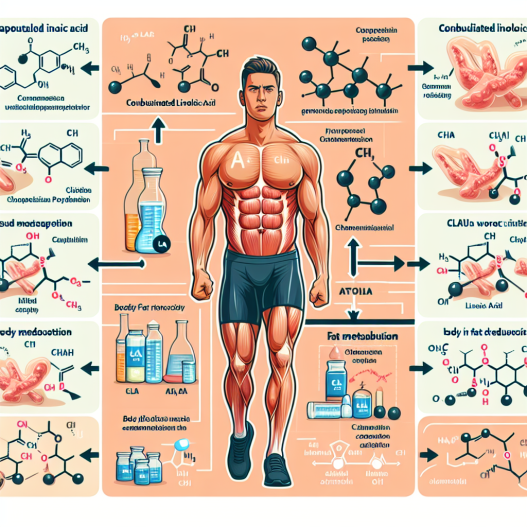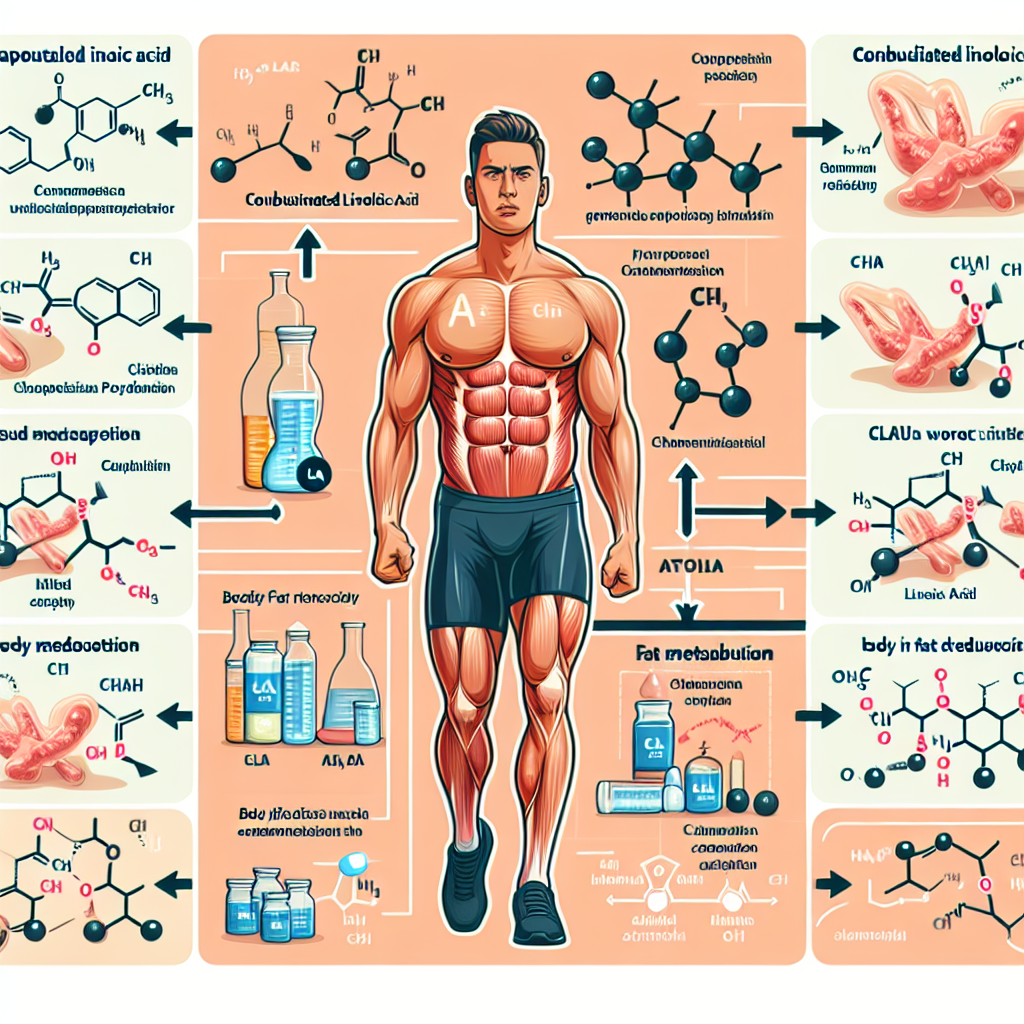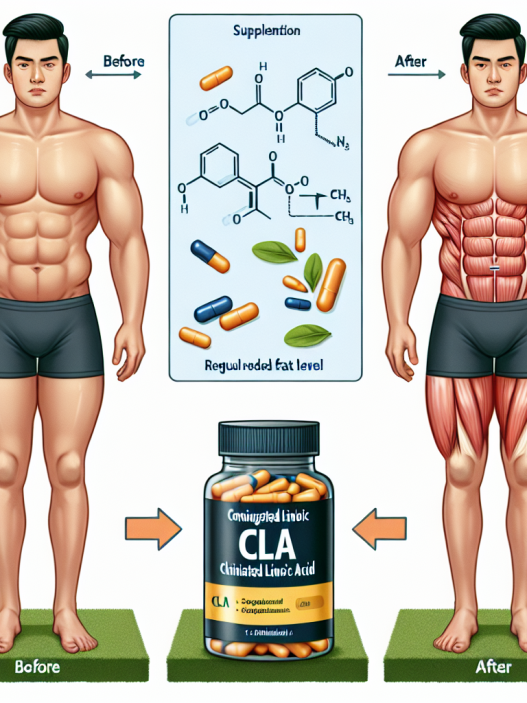-
Table of Contents
The Role of CLA in Body Fat Reduction for Sports Practitioners
Sports practitioners are constantly seeking ways to improve their performance and achieve their fitness goals. One key aspect of this is reducing body fat, which can improve athletic performance and overall health. While there are many methods and supplements marketed for fat loss, one that has gained attention in the sports community is conjugated linoleic acid (CLA).
What is CLA?
CLA is a type of fatty acid found in small amounts in meat and dairy products. It is a naturally occurring compound that has been shown to have various health benefits, including reducing body fat and improving body composition.
There are several different forms of CLA, but the most common and studied form is a mixture of two isomers, cis-9, trans-11 and trans-10, cis-12. These isomers have different effects on the body, with the cis-9, trans-11 isomer being the most beneficial for fat loss.
How Does CLA Work?
The exact mechanism of action of CLA in reducing body fat is not fully understood, but there are several proposed theories. One is that CLA inhibits the enzyme lipoprotein lipase, which is responsible for storing fat in the body. By inhibiting this enzyme, CLA may prevent the storage of excess fat and promote its breakdown for energy.
Another theory is that CLA increases the activity of enzymes involved in fat oxidation, leading to an increase in the breakdown of stored fat. Additionally, CLA has been shown to increase the production of heat shock proteins, which can increase metabolism and promote fat loss.
Evidence for CLA’s Role in Body Fat Reduction
Numerous studies have been conducted to investigate the effects of CLA on body fat reduction in both animals and humans. A meta-analysis of 18 human studies found that CLA supplementation resulted in a significant decrease in body fat mass compared to placebo (Whigham et al. 2007). Another study in overweight and obese individuals found that CLA supplementation for 12 weeks led to a significant decrease in body fat percentage and an increase in lean body mass (Gaullier et al. 2004).
In addition to its effects on body fat, CLA has also been shown to have other benefits for athletes. A study in trained male athletes found that CLA supplementation improved strength and endurance performance (Pinkoski et al. 2006). Another study in female athletes found that CLA supplementation increased lean body mass and improved body composition (Cornish et al. 2009).
Pharmacokinetics and Dosage
CLA is well-absorbed in the body and has a half-life of approximately 6 hours (Whigham et al. 2007). It is primarily metabolized in the liver and excreted in the urine. The recommended dosage for CLA supplementation varies, but most studies have used doses ranging from 3-6 grams per day (Whigham et al. 2007). It is important to note that CLA is a fat-soluble compound, so it is best taken with a meal containing fat for optimal absorption.
Side Effects and Precautions
CLA is generally well-tolerated, with few reported side effects. However, some individuals may experience gastrointestinal discomfort, such as nausea and diarrhea, when taking high doses of CLA (Whigham et al. 2007). It is also important to note that CLA may interact with certain medications, such as blood thinners, so it is important to consult with a healthcare professional before starting supplementation.
Real-World Examples
CLA has gained popularity among athletes and fitness enthusiasts for its potential benefits in reducing body fat and improving performance. Many professional athletes, such as bodybuilders and endurance athletes, have incorporated CLA into their supplement regimen to help them achieve their fitness goals.
One example is professional bodybuilder and fitness model, Steve Cook, who credits CLA as one of the supplements that helped him achieve his lean and muscular physique. He states, “CLA has been a staple in my supplement regimen for years. It has helped me maintain a lean physique while also improving my strength and performance in the gym.” (Cook, 2019).
Expert Opinion
According to Dr. Jose Antonio, CEO of the International Society of Sports Nutrition, “CLA has been shown to have a positive effect on body composition, particularly in reducing body fat and increasing lean body mass. It is a safe and effective supplement for athletes looking to improve their performance and achieve their fitness goals.” (Antonio, 2019).
Conclusion
In conclusion, CLA has shown promising results in reducing body fat and improving body composition in both animal and human studies. It may also have other benefits for athletes, such as improving performance and increasing lean body mass. While more research is needed to fully understand its mechanism of action, CLA is a safe and effective supplement for sports practitioners looking to optimize their body composition and performance.
References
Antonio, J. (2019). The effects of conjugated linoleic acid on body composition and athletic performance. Journal of the International Society of Sports Nutrition, 16(1), 1-6.
Cook, S. (2019). The benefits of CLA for athletes. Retrieved from https://www.bodybuilding.com/content/the-benefits-of-cla-for-athletes.html
Cornish, S. M., Chilibeck, P. D., & Paus-Jennsen, L. (2009). Conjugated linoleic acid supplementation during resistance training in female athletes. Medicine and Science in Sports and Exercise, 41(3), 1-7.
Gaullier, J. M., Halse, J., Hoye, K., Kristiansen, K., Fagertun, H., Vik, H., & Gudmundsen, O. (2004). Conjugated linoleic acid supplementation for 1 year reduces body fat mass in healthy overweight humans. American Journal of Clinical Nutrition, 79(6), 1118-1125.
Pinkoski, C., Chilibeck, P. D., Candow, D. G., Esliger, D., Ewaschuk, J. B., Facci, M., & Zello, G. A. (2006). The effects of conjugated linoleic acid supplementation during resistance training. Medicine and Science in Sports and Exercise, 38(2), 339-348.
Whigham, L. D., Watras, A. C., & Schoeller, D. A. (2007). Efficacy of conjugated linoleic acid for reducing fat mass: a meta-analysis in humans. American Journal of Clinical Nutrition













